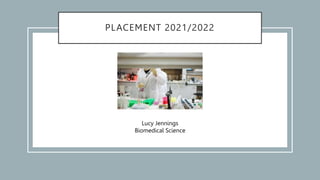
placement presentation.pptx
- 1. PLACEMENT 2021/2022 Lucy Jennings Biomedical Science
- 2. WHERE? • One of the worlds leading centers for neuroscience research. • Center includes neuroscience research, novel therapies and carrying out clinical trials. • Works to improve the lives of patients dealing with neurodegenerative diseases and their families.
- 3. WHAT DID I DO? • Worked with a team of researchers. • Did a range of laboratory work including biochemistry, molecular and cellular biology, protein immunoprecipitation, western immunoblotting, microscopy, genotyping and many more! • Completed laboratory chores.
- 4. I N V E S T I G AT E D T H E R O L E O F VA P B / P T P I P 5 1 I N T E R A CT I O N S I N T H E C R O S S TA L K B E T W E E N T H E E N D O P L A S M I C R E T I C U LU M A N D M I TO C H O N D R I A I N A L S • The area where the mitochondria and endoplasmic reticulum interact is the mitochondrial associated membrane (MAM). • This is known to regulate many cellular functions. • The disruption of these tethers therefore effects these cellular functions. • I focused on VAPB/PTPIP51
- 5. A TYPICAL WEEK MONDAY- - Meeting with the researchers - Split cells - Genotyping - Make cultures TUESDAY- - Make new plasmids - Transfect the cells - Treat the cells - Genotyping WEDNESDAY- - Scrape cells, calculate concentrations and make input and IP samples THURSDAY- - Run a SDS-PAGE gel - Western blot - Add primary antibodies to the membrane - Split cells FRIDAY- - Laboratory group meeting - Secondary antibodies - Analyse the results
- 6. SUCCESSES AND CHALLENGES SUCCESSES- • Learnt a broad range of techniques. • Discovered what working in a functioning laboratory is like. • Found my interests. • Overcome challenges • Experienced working with a range of people. CHALLENGES- • First few days or weeks can be difficult. • Needed to repeat experiments several times.
- 7. THANKS FOR LISTENING! ANY QUESTIONS?